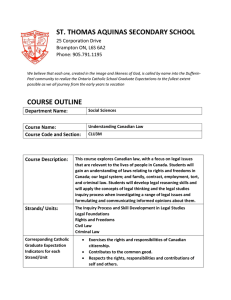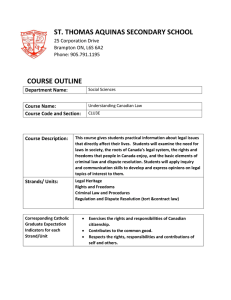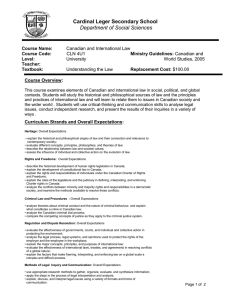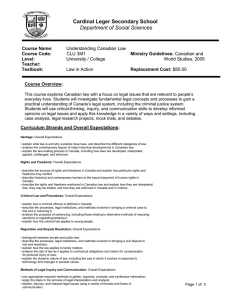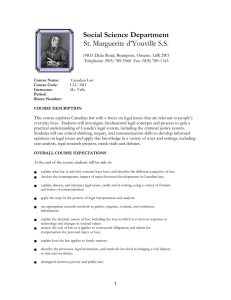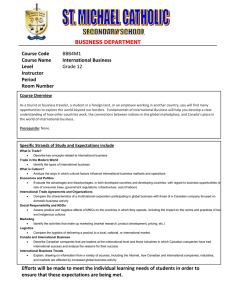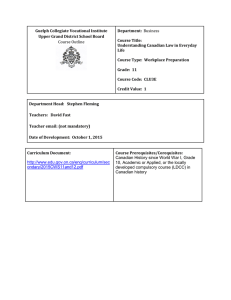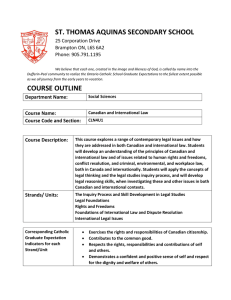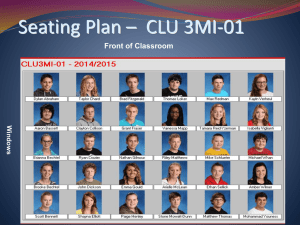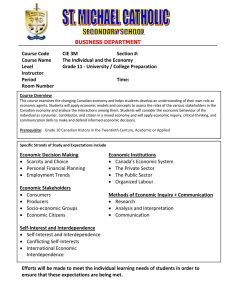Department of Canadian & World Studies John Cabot Catholic Secondary School
advertisement
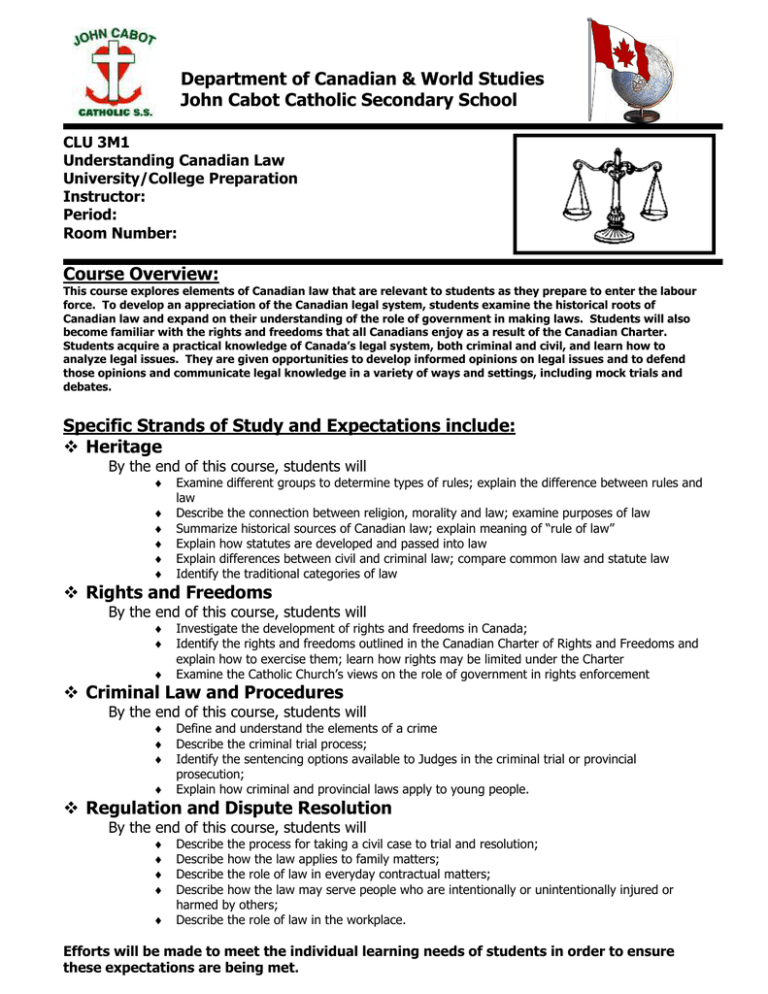
Department of Canadian & World Studies John Cabot Catholic Secondary School CLU 3M1 Understanding Canadian Law University/College Preparation Instructor: Period: Room Number: Course Overview: This course explores elements of Canadian law that are relevant to students as they prepare to enter the labour force. To develop an appreciation of the Canadian legal system, students examine the historical roots of Canadian law and expand on their understanding of the role of government in making laws. Students will also become familiar with the rights and freedoms that all Canadians enjoy as a result of the Canadian Charter. Students acquire a practical knowledge of Canada’s legal system, both criminal and civil, and learn how to analyze legal issues. They are given opportunities to develop informed opinions on legal issues and to defend those opinions and communicate legal knowledge in a variety of ways and settings, including mock trials and debates. Specific Strands of Study and Expectations include: Heritage By the end of this course, students will Examine different groups to determine types of rules; explain the difference between rules and law Describe the connection between religion, morality and law; examine purposes of law Summarize historical sources of Canadian law; explain meaning of “rule of law” Explain how statutes are developed and passed into law Explain differences between civil and criminal law; compare common law and statute law Identify the traditional categories of law Rights and Freedoms By the end of this course, students will Investigate the development of rights and freedoms in Canada; Identify the rights and freedoms outlined in the Canadian Charter of Rights and Freedoms and explain how to exercise them; learn how rights may be limited under the Charter Examine the Catholic Church’s views on the role of government in rights enforcement Criminal Law and Procedures By the end of this course, students will Define and understand the elements of a crime Describe the criminal trial process; Identify the sentencing options available to Judges in the criminal trial or provincial prosecution; Explain how criminal and provincial laws apply to young people. Regulation and Dispute Resolution By the end of this course, students will Describe the process for taking a civil case to trial and resolution; Describe how the law applies to family matters; Describe the role of law in everyday contractual matters; Describe how the law may serve people who are intentionally or unintentionally injured or harmed by others; Describe the role of law in the workplace. Efforts will be made to meet the individual learning needs of students in order to ensure these expectations are being met. Mark Breakdown: Course Breakdown Unit One: Heritage 20 hours Unit Two: Rights and Freedoms 20 hours Efforts will be made to meet the Unit Three: Criminal Law and Procedures individual learning 35 hours to ensure these expectations are being met. Unit Four: Regulation and Dispute Resolution 35 hours Unit Five: Methods of Legal Inquiry Throughout Marks will be recorded according to the following competencies: Knowledge/ Understanding 20% Thinking/ Inquiry 25% Communication 25% needs of students in order Application 30% Furthermore, evaluation is divided as: Term Work 70% Summative work of 30% - Summative works consists of the Final Exam (20%)and a Culminating Activity (10%) Resources: The course will use a variety of resources including video, CD-ROM, the Internet and a variety of print sources. The textbook All About Law – Sixth Edition will be distributed to students. The text and all other resources assigned to students are the responsibility of the student. Any damage or loss incurred will result in payment for replacement. The replacement cost is $80.00. Evaluation Policy Students will be assessed & evaluated according to the work produced & skills displayed. Methods of providing feedback will include assessing work in process & evaluating completed assignments, tests, co-operative learning activities, simulations and presentations. Peer & self-evaluations will also be utilized. Student marks will be determined by evaluating process & product according to 4 categories & 4 levels. Please see the chart below for specific skills and key words used to determine student competency in the different categories. Category Level Knowledge/Understanding Knowledge of facts & terms Understanding of concepts & relationships Thinking/Inquiry Critical thinking skills Creative thinking skills Inquiry Skills Communication Communication of ideas and information Use of symbols & visuals Oral & written communication Level 1: 50-59% Level 2: 60-69% Level 3: 70-79% Level 4: 80-100% -Limited display of knowledge, skills and ability to apply concepts -Some success in displaying knowledge, skills and application of concepts -Considerable display of knowledge skills and ability to apply concepts -Thorough understanding of concepts and ability to communicate, think creatively & apply concepts Application Applications in familiar contexts Transfer of concepts to new contexts Making logical conclusions and predictions Use of technology Making connections Feedback will also be provided for student learning skills. Skills like working independently, team work, organization, work habits and homework, and initiative are assessed independently student achievement and will be conducted through the use of a rubric indicating specific criteria to be achieved to receive each of the following letter grades: E –Excellent Other Evaluation Issues G – Good S – Satisfactory N - Needs Improvement LATE ASSIGNMENTS – assignments submitted after the Primary Due Date established by the teacher will be accepted with a penalty of 5% off for the first day late and 2% for subsequent days to a maximum of 10%. This four day Penalty Zone is the maximum time allowed for submissions. The fourth day after the assignment is due is considered the Closure Date upon which no further assignments will be accepted. If the teacher returns the marked assignments within the four day penalty zone, the date of return is considered the closure date. Repeated lateness in submissions indicates poor organization skills and will result in parental contact and will be reflected in the learning skills section of the report card. INCOMPLETE ASSIGNMENTS – assignments will be graded according to the extent with which they meet the criteria established in the rubric or evaluation structure. MISSED TESTS – Tests missed with a legitimate reason will be written within a few days of the student returning from the absence. Student eligibility to write the test and the date of writing will be at the discretion of the teacher in consultation with the department head. CULMINATING ACTIVITIES – These activities will be due toward the end of the course. They are valued between 5 and 15 percent of the final mark and will reflect course material and competencies not otherwise reflected on the final exam.
